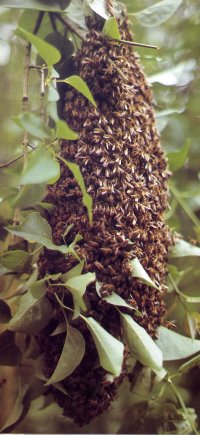
Encyclopedia of Beekeeping ed. Roger Morse & Ted Hooper
Honeybees swarm in order to extend the species by increasing the number of colonies. The original hive is left with queen cells and non-flying bees while the swarm has the flying bees clustered around the old queen. A swarm often settles in bushes or trees but this is normally a temporary resting place until scout bees find an appropriate place to form a new colony. The behaviour is most prevalent from April to July.
A swarm is normally passive as long as the bees are fully gorged on honey. In fact some people have fashioned beards from them. However, this is not a recommended pastime. If you encounter a swarm, then try to remain calm and avoid aggravating activities such as the use of petrol lawnmowers and hedge trimmers.
| Official swarm collectors for the K&SW Beekeepers | |
|---|---|
| Name | Contact Details |
| Peter Llewellyn | Tel: 015395 62369 |
| Eifion Jones | Tel: 07989519610 |
| Jonathan Blakeway Smith | Tel: 07950491000 |